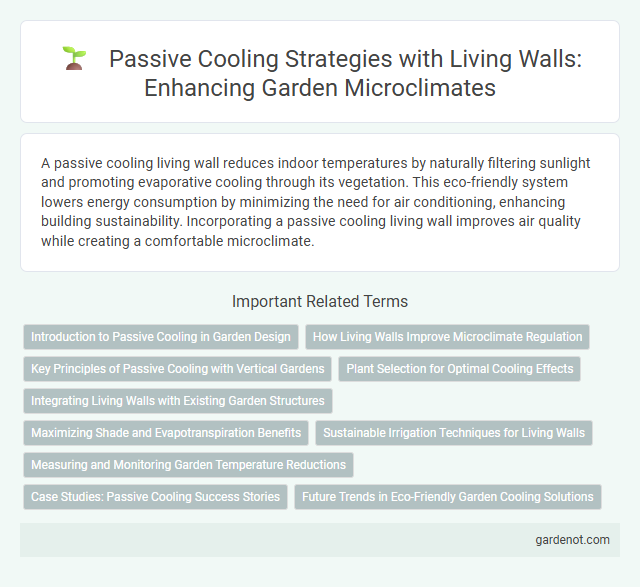A passive cooling living wall reduces indoor temperatures by naturally filtering sunlight and promoting evaporative cooling through its vegetation. This eco-friendly system lowers energy consumption by minimizing the need for air conditioning, enhancing building sustainability. Incorporating a passive cooling living wall improves air quality while creating a comfortable microclimate.
Introduction to Passive Cooling in Garden Design
Passive cooling living walls utilize natural ventilation and shading to reduce garden temperatures without mechanical systems. Incorporating plants with high transpiration rates and strategic placement enhances evaporative cooling effects, improving microclimate comfort. These green installations contribute to energy efficiency and sustainable garden design by minimizing heat absorption and promoting airflow.
How Living Walls Improve Microclimate Regulation
Passive cooling living walls enhance microclimate regulation by reducing ambient temperatures through natural transpiration and shading, improving air quality with increased oxygen production and pollutant absorption. These green facades lower heat islands around buildings by blocking solar radiation and facilitating evaporative cooling, leading to more stable humidity levels and thermal comfort. The integration of diverse plant species in living walls supports biodiversity while optimizing energy efficiency in urban environments.
Key Principles of Passive Cooling with Vertical Gardens
Passive cooling with vertical gardens leverages the natural processes of evapotranspiration and shading to reduce building temperatures. Key principles include selecting drought-resistant plants that efficiently transpire water, optimizing wall orientation for maximum shade during peak heat, and integrating porous substrates to facilitate air circulation. This approach minimizes reliance on mechanical cooling, enhances urban microclimates, and improves energy efficiency in buildings.
Plant Selection for Optimal Cooling Effects
Selecting drought-tolerant and evapotranspiring plant species such as ferns, succulents, and ivy enhances passive cooling in living walls by maximizing natural shade and moisture release. Plants with large, broad leaves increase transpiration rates, creating a cooling microclimate that reduces surrounding air temperature. Integrating native species adapted to local climate conditions ensures sustainability and efficient thermal regulation.
Integrating Living Walls with Existing Garden Structures
Integrating passive cooling living walls with existing garden structures enhances microclimate regulation by increasing shade and reducing ambient temperatures through natural evapotranspiration. Utilizing compatible climbing plants or modular green panels allows seamless attachment to fences, pergolas, and trellises, optimizing space without disrupting garden aesthetics. This approach not only promotes energy efficiency but also boosts biodiversity and air quality in urban landscapes.
Maximizing Shade and Evapotranspiration Benefits
Passive cooling living walls enhance building temperature regulation by maximizing shade and promoting evapotranspiration, which reduces heat absorption on exterior surfaces. Dense foliage blocks direct solar radiation, lowering surface temperatures, while transpiration from plant leaves cools the surrounding air through moisture release. Integrating species with high transpiration rates and strategic plant placement optimizes these natural cooling processes, significantly reducing energy consumption for air conditioning.
Sustainable Irrigation Techniques for Living Walls
Sustainable irrigation techniques for passive cooling living walls prioritize water conservation through drip irrigation systems that deliver moisture directly to plant roots, reducing evaporation and runoff. Incorporating rainwater harvesting and greywater recycling enhances efficiency by utilizing alternative water sources, minimizing freshwater consumption. Selecting drought-tolerant plant species further optimizes water use, maintaining wall vitality while contributing to urban heat reduction.
Measuring and Monitoring Garden Temperature Reductions
Passive cooling living walls significantly reduce garden temperatures by enhancing natural shading and evapotranspiration. Measuring temperature reductions involves deploying sensors at multiple points on and around the living wall to capture real-time thermal data. Monitoring this data over time demonstrates consistent decreases in ambient and surface temperatures, confirming the living wall's effectiveness in passive cooling.
Case Studies: Passive Cooling Success Stories
Case studies of passive cooling living walls demonstrate significant temperature reductions of up to 10degC on building facades, enhancing indoor thermal comfort without mechanical air conditioning. Projects like the Bosco Verticale in Milan and the Oasia Hotel Downtown in Singapore showcase how dense vegetation and strategic plant selection facilitate natural shading and evapotranspiration, resulting in energy savings of up to 30%. These success stories underline the efficacy of passive cooling living walls in urban heat island mitigation and sustainable building design.
Future Trends in Eco-Friendly Garden Cooling Solutions
Passive cooling living walls utilize vertical plant installations to reduce ambient temperatures through natural shading and evapotranspiration, significantly lowering energy consumption in urban environments. Future trends in eco-friendly garden cooling solutions emphasize integrating smart sensor technology to optimize irrigation and plant health, enhancing thermal regulation efficiency. Advances in drought-resistant and native plant species selection promote sustainability, making passive cooling living walls a key component in climate-adaptive urban design.
Passive cooling living wall Infographic

 gardenot.com
gardenot.com